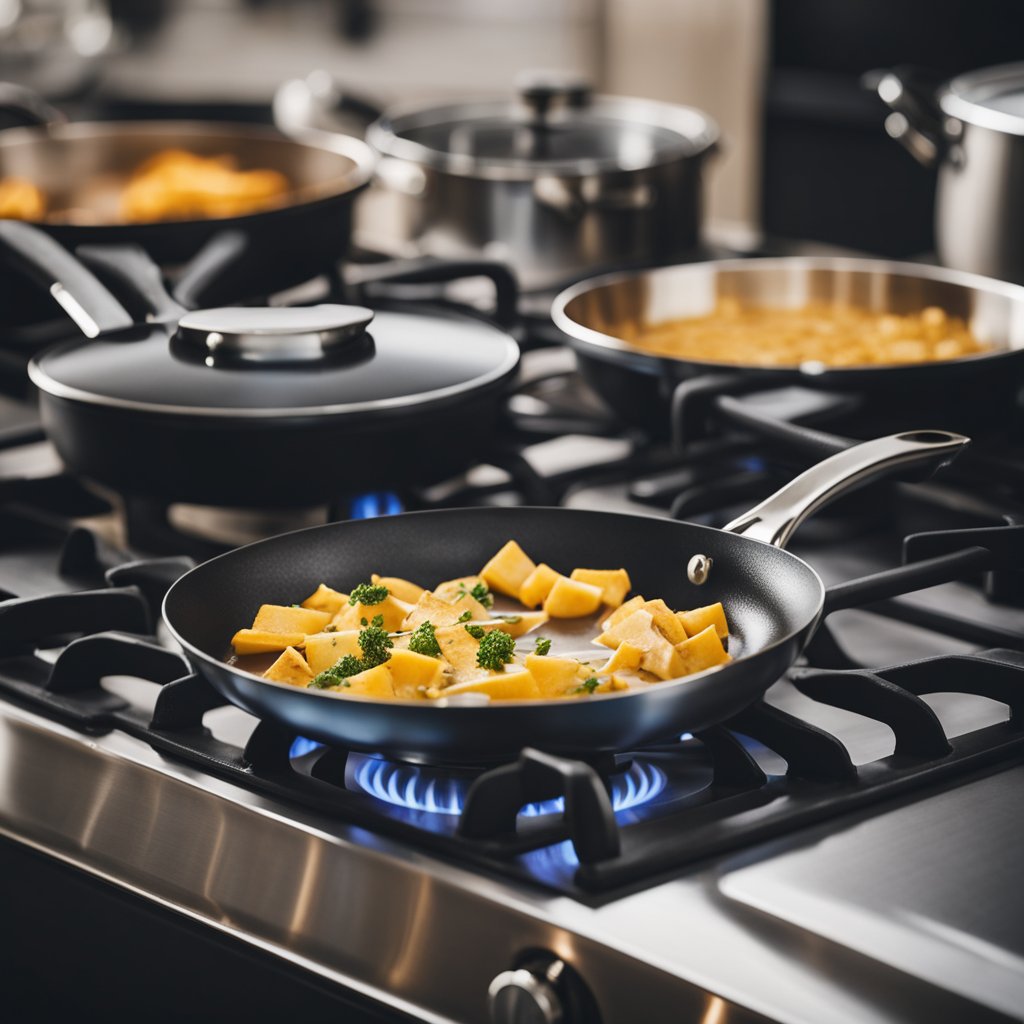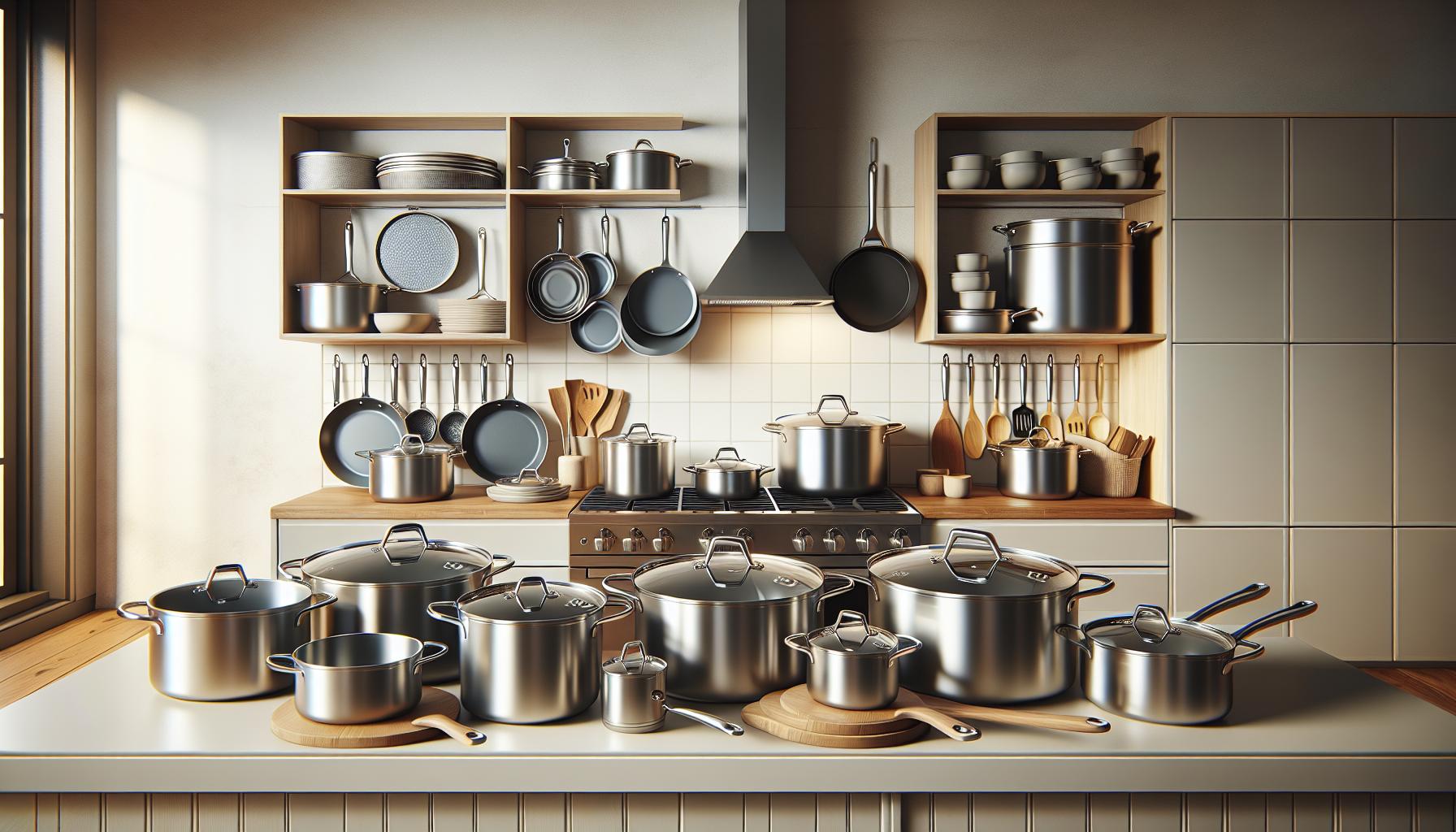This post contains affiliate links. See the affiliate disclaimer here.
Are you tired of your pots and pans not working on your induction cooktop? If so, it’s time to learn about non-induction cookware.
Non-induction cookware is specifically designed to be used on traditional stovetops, making it incompatible with induction cooking.
In this article, we’ll explore what non-induction cookware is, how it differs from induction cookware, and why it’s important to have the right cookware for your specific cooking needs. So, if you’re ready to upgrade your kitchen arsenal, keep reading to discover everything you need to know about non-induction cookware.
What Is Non-Induction Cookware?
Non-induction cookware refers to a type of cooking equipment that is specifically designed to be used on traditional stovetops, such as gas or electric stoves. It is important to understand that non-induction cookware is not compatible with induction cooking.
So, what makes non-induction cookware different from other types of cookware? The key difference lies in the material used for the construction of the cookware. Non-induction cookware is typically made from materials that are not magnetic, such as stainless steel, aluminum, or copper.
Induction cooking, on the other hand, requires magnetic cookware. This is because the heat is generated directly in the cookware through electromagnetic induction, rather than being transferred from the stovetop to the cookware through direct contact.
It’s important to have the right type of cookware for your specific cooking needs. Non-induction cookware is the go-to choice for those who have traditional stovetops and do not plan on switching to induction cooking anytime soon.
In the next section, we will explore the advantages of using non-induction cookware and why it might be the perfect fit for your kitchen. So, keep reading to learn more.
Features of Non-Induction Cookware

When it comes to cooking on a gas or electric stove, non-induction cookware is an essential kitchen companion. Non-induction cookware is specifically designed to work with traditional stovetops, providing you with the perfect tools to create delicious meals. Let’s take a closer look at the features that make non-induction cookware a great choice for your cooking needs:
1. Material:
Non induction cookware is typically made from materials that easily conduct heat, such as stainless steel, aluminum, or cast iron. These materials ensure even heat distribution, helping to cook your food evenly and efficiently. Additionally, the construction of non induction cookware makes it durable and long-lasting, allowing you to enjoy it for years to come.
2. Compatibility:
One of the key features of non induction cookware is its compatibility with gas and electric stoves. These cookware sets have flat bottoms that make direct contact with the heating element, maximizing heat transfer and ensuring optimal cooking performance. This compatibility allows you to use non induction cookware with ease and convenience on your existing stovetop.
3. Versatility:
Non induction cookware offers a wide range of options and versatility in the kitchen. You can find non induction pots, pans, skillets, and more, allowing you to choose the right utensil for various cooking techniques. Whether you’re sautéing vegetables, simmering sauces, or frying up a steak, non induction cookware has got you covered.
4. Cost-effective:
Compared to induction cookware, non induction cookware tends to be more affordable. It offers excellent quality at a reasonable price, making it a budget-friendly option for many home cooks. Investing in non induction cookware allows you to enjoy the benefits of high-quality cookware without breaking the bank.
5. Easy to clean:
Non induction cookware is generally easy to clean, thanks to its smooth surfaces and non-stick coatings. Many non induction pots and pans are dishwasher safe, saving you time and effort in the kitchen. Proper cleaning and maintenance of your non induction cookware will help prolong its lifespan and ensure that it remains in excellent condition.
Non induction cookware stands out for its material, compatibility, versatility, cost-effectiveness, and easy cleaning. With these features, non induction cookware is a reliable choice for your everyday cooking needs on gas or electric stovetops.
Differences Between Non Induction Cookware and Induction Cookware
When it comes to cookware, it’s important to understand the key differences between non induction cookware and induction cookware. While non induction cookware is designed to work on gas or electric stoves, induction cookware is specifically made for induction cooktops. Here’s what you need to know:
- Material Composition: Non induction cookware is typically made from materials that conduct heat well, such as stainless steel, aluminum, or cast iron. On the other hand, induction cookware is made from materials that are magnetic, such as stainless steel or cast iron. This is because induction cooktops use magnetic fields to generate heat, requiring cookware that can respond to this method.
- Heat Distribution: Non induction cookware distributes heat evenly across the bottom and sides of the pot or pan, ensuring that your food cooks uniformly. Induction cookware, on the other hand, heats up quickly and evenly thanks to its magnetic properties. This allows for precise temperature control and faster cooking times.
- Cooking Efficiency: Induction cookware is known for its efficiency as it transfers heat directly to the cookware via electromagnetic waves. This means that less heat is wasted, resulting in shorter cooking times and lower energy consumption. Non induction cookware, while still effective, may require more time to heat up and can result in some heat loss.
- Compatibility: An important difference between the two types of cookware is their compatibility with different stovetops. Non induction cookware works perfectly on gas or electric stoves, while induction cookware is specifically designed to be used on induction cooktops only. So, if you plan on using induction cookware, make sure you have an induction cooktop.
- Price Range: The price range for non-induction cookware is generally more affordable compared to induction cookware. Non-induction cookware is widely available and comes in various price ranges to suit different budgets. Induction cookware, on the other hand, tends to be more expensive due to the specialized materials required for its production.
Understanding the differences between non induction cookware and induction cookware will help you make an informed decision when choosing the right cookware for your kitchen. Whether you have a traditional gas or electric stove or an induction cooktop, there is a wide range of cookware options available to meet your needs.
Advantages and Disadvantages of Non Induction Cookware
Non induction cookware, as the name suggests, is cookware that is not compatible with induction cooktops. It is typically made from materials that conduct heat well, such as stainless steel, aluminum, or cast iron. While non-induction cookware has its advantages, it also has a few disadvantages that you should be aware of when considering it for your kitchen.
Here are some of the advantages of non induction cookware:
- Affordability: One of the main advantages of non induction cookware is its affordability. Non induction cookware is generally more budget-friendly compared to induction cookware. If you are on a tight budget, non induction cookware can be a great option for you.
- Wide Availability: Non induction cookware is widely available and can be found in most stores that sell kitchenware. Whether you prefer shopping online or in physical stores, you’ll have no trouble finding a wide range of non induction cookware options.
- Compatibility with Traditional Stovetops: Non induction cookware is compatible with traditional gas and electric stovetops. If you have a non induction stovetop and don’t plan on switching to an induction cooktop, non induction cookware is a practical choice.
- Durability: Non induction cookware, especially those made from stainless steel or cast iron, is known for its durability. It can withstand high temperatures and is resistant to scratches and dents, making it a long-lasting investment.
However, it’s also important to consider the disadvantages of non induction cookware:
- Slower Heating: Non induction cookware takes longer to heat up compared to induction cookware. This means that it may take more time to bring your food to the desired temperature, which can be an inconvenience if you’re in a hurry.
- Uneven Heat Distribution: Non induction cookware tends to have uneven heat distribution, which can result in hot spots on the surface of the cookware. This can make it challenging to cook delicate dishes that require precise and even heat.
- Limited Compatibility: Non induction cookware cannot be used on induction cooktops. If you’re planning to upgrade your kitchen appliances to induction in the future, you’ll need to replace your non induction cookware with induction-compatible options.
Tips for Choosing the Right Non Induction Cookware
When it comes to selecting non induction cookware for your kitchen, there are a few key factors to consider. Keep these tips in mind to ensure that you choose the right cookware that suits your needs and cooking style.
- Material: The material of the cookware plays a crucial role in its performance and durability. Non induction cookware is commonly made from stainless steel, aluminum, or cast iron. Stainless steel is known for its durability and easy maintenance, while aluminum offers excellent heat conductivity. Cast iron is renowned for its heat retention, making it ideal for slow cooking.
- Heat Distribution: Look for cookware that provides even heat distribution. Uneven heat distribution can result in hot spots, leading to unevenly cooked food. To ensure even heating, consider cookware with a multi-layered construction or a bonded metal base.
- Compatibility: While non induction cookware is compatible with traditional stovetops, it may not be suitable for induction cooktops. Induction cooktops require cookware that is magnetic and has a flat bottom. If you have an induction cooktop or plan to upgrade to one in the future, opt for cookware specifically designed for induction cooking.
- Handles and Lid: Comfortable and sturdy handles are essential for safe handling of the cookware. Look for handles that are heat-resistant and securely attached to the cookware. Additionally, a well-fitting lid helps to seal in heat and moisture, enhancing cooking efficiency.
- Maintenance: Consider the maintenance requirements of the cookware. Some materials may require special care, such as seasoning for cast iron or avoiding abrasive cleaners for stainless steel. Choose cookware that aligns with your willingness to invest time and effort in maintenance.
- Budget: Set a budget before shopping for non induction cookware. Prices can vary greatly depending on the material, brand, and quality. Assess your needs and prioritize features that are most important to you to make an informed decision that fits within your budget.
Conclusion
Choosing the right non induction cookware for your kitchen is essential for efficient and enjoyable cooking experiences. By considering factors such as material, heat distribution, compatibility with induction cooktops, handles and lid, maintenance requirements, and budget, you can make an informed decision that suits your needs and cooking style.
The material of the cookware plays a significant role in its performance. Whether you prefer stainless steel, cast iron, or aluminum, each material has its own benefits and considerations. Heat distribution is another crucial aspect to consider, as even heat distribution ensures that your food cooks evenly.
Compatibility with induction cooktops is important if you plan to use your cookware on these types of stoves. Look for cookware that has a magnetic base for optimal performance. Additionally, the handles and lid should be sturdy and comfortable to use, providing a secure grip.
Maintenance requirements vary depending on the type of cookware you choose. Some may require special care, while others are dishwasher safe. Finally, consider your budget and choose cookware that offers the right balance of quality and affordability.
By following these tips, you can select the perfect non induction cookware that meets your needs and enhances your cooking experience.
Frequently Asked Questions
Q: What factors should I consider when choosing non induction cookware?
A: When choosing non induction cookware, consider factors such as the material (e.g., stainless steel, cast iron), heat distribution (even heating), compatibility with induction cooktops (if you plan to use it in the future), handles and lid (secure and heat-resistant), maintenance requirements (easy to clean), and budget (affordable). These factors will ensure you select cookware that is suitable for your needs and cooking style.
Q: What materials are commonly used for non induction cookware?
A: The commonly used materials for non induction cookware include stainless steel, cast iron, aluminum, copper, and ceramic. Each material has its advantages and disadvantages, so choose one based on your preferences and cooking needs.
Q: Can non induction cookware be used on induction cooktops?
A: No, non induction cookware cannot be used on induction cooktops as they require a magnetic field to generate heat. To cook on an induction cooktop, you need cookware that is specifically designed for induction cooking, which has a magnetic bottom that can interact with the cooktop’s magnetic field.
Q: What are the benefits of even heat distribution in non induction cookware?
A: Even heat distribution in non induction cookware ensures that food cooks evenly and prevents hot spots. This results in better cooking performance and helps to avoid burnt or undercooked food.
Q: How should I maintain non induction cookware?
A: To maintain non induction cookware, clean it with mild dish soap and warm water. Avoid using abrasive cleaners or harsh scouring pads that may damage the surface. Also, make sure to dry the cookware thoroughly after cleaning to prevent any moisture-related issues such as rust or corrosion.
Q: Is non induction cookware more affordable compared to induction cookware?
A: Non induction cookware generally tends to be more affordable compared to induction cookware. However, the price may vary depending on the quality, brand, and material of the cookware you choose. It is recommended to set a budget and compare prices to find cookware that offers good value for money.

